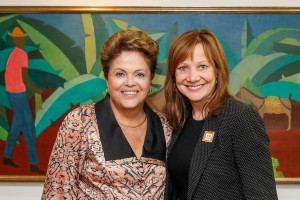
Brazilian President Dilma Roussef, left, and GM CEO Mary Barra are all smiles after Barra announced the maker was investing $2.9 billion there.
General Motors plans to invest $2.9 billion during the next five years in Brazil for product development, new technologies and employee training. The cash infusion is a reminder of the importance the maker places on the potential of the Brazilian market.
“This investment will allow the Chevrolet brand continue to renew its lineup with a focus on technology and quality,” said Jaime Ardila, president of GM South America, in a statement.
“Another major purpose of this contribution is to raise the percentage of nationalization of the components of the cars made in Brazil, in an action that also involves suppliers installed in the country.”
The Detroit-based maker’s commitment in Brazil comes despite the fact that the economy there is stagnant. Brazil’s auto industry has cut production by 16% in the first seven months of the year. Autos account for about 20% of the country’s industrial output.
Brazil has been subject to a lot of scrutiny recently. The government there was riding a public relations high with the World Cup coming to the country in June and July; however, protestors managed to steal the spot light for a few moments to highlight problems with basic public services, education and the sluggish economy. They complained that the billions spent on new stadiums and related projects for the soccer tournament – as well as the Olympic Games in 2016 – should be used for education and economic revival.
GM’s move is proactive, according to Dave Sullivan, analyst at AutoPacific in Ann Arbor, Michigan. With the staid economy, the automaker is getting more bang for its buck. In spite of the millions, and potentially billions, the maker is spending due to recall issues, the company is relatively healthy from a financial standpoint so putting the money into the country now to be ready for an expected turnaround in the coming years is smart.
“There’s a lot of pent up demand in Brazil,” Sullivan said. “I think they’re making an investment now in anticipation of the turnaround. Instead of a knee jerk reaction, they’ll be ready to hit the ground running.”
(Used car buyers get relief as prices tumble. For more, Click Here.)
Sullivan notes that the investment doesn’t come without some level of risk. It was just about 10 years ago when Brazil was expected to be the next booming auto sales nirvana and many automakers invested heavily to try to take advantage of the anticipated boom. In fact, Ford’s largest – employing nearly 8,800 people – and perhaps most modern plant stands at the ready in Bahia.
However, that sales explosion has yet to materialize.
(Click Here for details on how affordable hydrogen could improve sales of fuel-cell vehicles.)
Now there is a capacity glut – though not for GM, Sullivan says – in the country, which is being dealt with right now by automakers slashing jobs. Until the government finalizes its plans for turning around the country’s economy, which experienced a mini-boom when oil reserves were found in its territorial waters several years ago, everything related to the auto industry will remain in flux, Sullivan noted.
“It’s a developing country,” he said. “It’s still dealing with the issues of becoming a big boy (economically).”
(To see why Toyota expects to sell 100,000 more cars this year, Click Here.)
The uncertainty hasn’t stopped others from plowing cash into the country in recent years. Ford announced in 2010 it was investing an estimated $2.4 billion through 2015 into the development of its EcoSport CUV for the country.
In 2012, the Brazilian government expected $22 billion to be invested by automakers, such as Fiat, Volkswagen, GM and others, but wanted to get more, including some Chinese investment. In some respects, it was a safe bet there would be more because of Brazil’s protective tariffs on vehicles imported into the country. The country basically eliminated all imports from Mexico, although it still sees a heavy influx of vehicles from China, but even that’s getting restricted.
“It’s a very different place than the rest of the world,” Sullivan said. “It you want to sell there, you need to invest there.”
